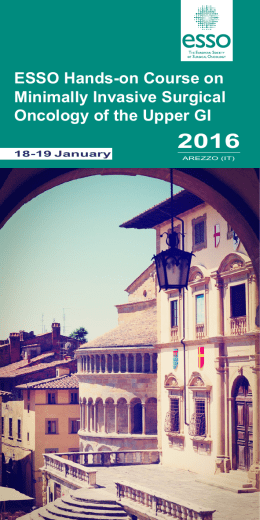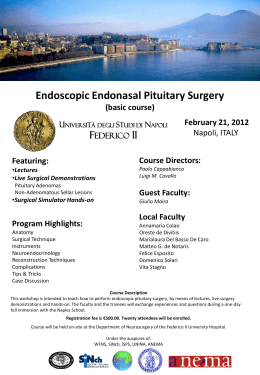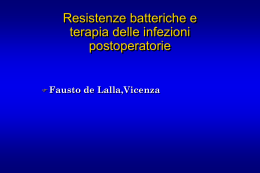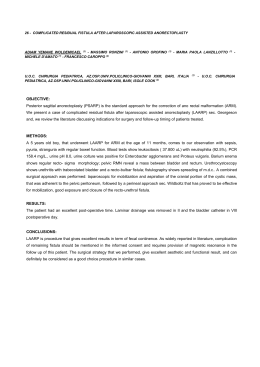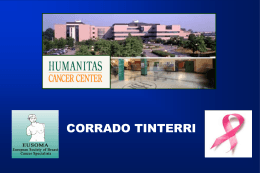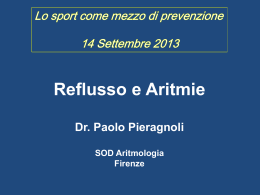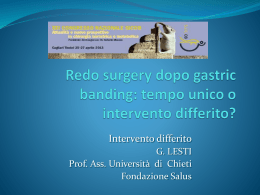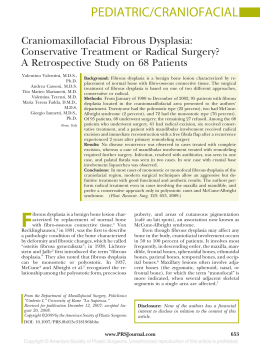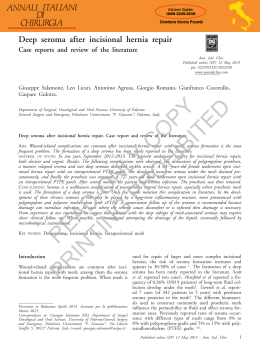Prof. Sandro Mattioli in qualità di docente dell’evento sopra indicato, ai sensi dell’art. 3.3 sul Conflitto di Interessi, pag. 17 del Reg. Applicativo dell’Accordo Stato-Regioni del 5/11/09, per conto del provider I&C srl dichiara che negli ultimi due anni non ha avuto rapporti con soggetti portatori di interessi commerciali in campo sanitario The “point” on GERD Surgery Sandro Mattioli Division of Thoracic Surgery Center for the Study and Therapy of Diseases of the Esophagus Alma Mater Studiorum - University of Bologna GVM Care and Research Cotignola Italy Medical versus surgical management for gastrooesophageal reflux disease (GORD) in adults Wileman SM et al. Cochrane Database Syst Rev. 2010 Mar 17;(3):CD003243 • A total of 173 titles and/or abstracts were read independently by the authors. • Of these, 12 potential papers for full critical appraisal were obtained. The papers reported data at multiple timepoints from four clinical trials: One study in 11 European countries (LOTUS Trial 2008) Two multicentric studies in the UK (Mahon 2005; REFLUX Trial 2008) The remaining study in a single centre in Canada (Anvari 2006) • Sample sizes ranged from 104 to 554 participants, with a total of 1232 randomised participants. Medical vs laparoscopic surgical management, outcome: Health-related quality of life (SF-36). Medical vs laparoscopic surgical management, outcome: Healthrelated quality of life (EQ-5D). Surg Endosc 2010; 24:2647–2669 Methodology • A total of 293 graded articles relevant to this guideline were reviewed. • Randomized controlled trials, metaanalyses, and systematic reviews were selected for further review, along withprospective and retrospective studies that included at least 50 patients. • Studies with smaller samples were considered when additional evidence was lacking. The most recent reviews were also included. • All case reports, older reviews, and smaller studies were excluded. Surg Endosc 2010; 24:2647–2669 INDICATIONS FOR SURGERY Surgical therapy should be considered in individuals who: • Have failed medical management (inadequate symptom control, severe regurgitation not controlled with acid suppression, or medication side-effects) OR •Opt for surgery despite successful medical management (due to quality-of-life considerations, lifelong need for medication intake, expense of medications, etc.) OR • Have complications of GERD (e.g., Barrett’s esophagus,peptic stricture) OR • Have extra-esophageal manifestations (asthma, hoarseness, cough, chest pain, aspiration) . Indications and Techniques for the Surgical Treatment of GERD Indications for Surgical Therapy in GERD • Pts non responders to medical therapy. • Pts not compliant with long term medical therapy. • Pts requiring high dosages of drugs. • Pts too young for a lifetime medical treatment. Spechler SJ et al. JAMA 2001; 285:2331-2338 Watson DI et al. GUT 1999; 45: 791-792 Baldi F et al. Ital J Gastroenterol Hepatol. 1998; 30(1):107-12 Galmiche JP et al. BMJ 1998; 316: 1720-1723 Galmiche JP et al. Acta Gastroenterol Belg 1998;61(4):438-49 • Pts with the axial intrathoracic migration of the GE junction and severe GERD. L’Esofago Corto nella MRGE Cause della controversia • La posizione intratoracica della GEG nello studio preoperatorio (Radiologia – Endoscopia) ha significato fisiopatologico e predittivo , ma non sempre corrisponde ad un vero esofago corto. • Può essere difficile individuare intraoperatoriamente la GEG e la sua posizione rispetto allo hiatus diaframmatico. The Intrinsic and Extrinsic Components of the LES RK Mittal, DH Balaban. N Engl J Med 1997,336;13:924-32. Radiologic Classification of Hiatus Hernia a b Normal GEJ Sliding Hiatus Hernia Hiatal Insufficiency Concentric Hiatus Hernia Short Esophagus Incarcerated Hiatus Hernia Radiologic Classification of Hiatus Hernia T E angle of HIS P HH A D EGJ EGJ HH EGJ SS Z-line EGJ Normal EGJ Hiatal Insufficiency Wolf BS 1960 Rex JC, Andersen HA, Bartholomew LG, Cain JC 1961 Concentric Short Hiatus Hernia Esophagus Zaino C, Poppel MH, et al. 1963 Pringot J, Ponette E 1974. Position of the Lower Esophageal Sphincter with respect to the Diaphragmatic Dome p= .0002 10 cm 5 Diaphragmatic dome 0 cm 5 p= .02 p= .02 p= .0002 Normal Hiatal Concentric Short GEJ Insufficiency Hiatus Esophagus Hernia S.Mattioli et al. J Thorac Cardiovasc Surg 1998; 116: 267-75. LES resting tone mmHg 30 25 20 15 10 5 0 p=.00003 p=.00002 p=.0001 p=.0001 p=.008 p=.0002 HV SHH HI CHH SE Acid GER 24-hr Ph recording Time % pH <4 30 25 20 15 10 5 0 p=.00003 p=.00002 p=.0001 p=.01 p=.001 p=.01 HV SHH HI CHH SE S Mattioli et al. J Thorac Cardiovasc Surg 1998; 116: 267-75 GERD Surgery and Short Esophagus • Not the Sliding Hiatus Hernia but the Permanent Axial Orad Migration of the gastroesophageal junction above the hiatus is correlated with severity of GERD. • In 80% of cases the intrathoracic migration of the gastroesophageal junction is associated with esophagitis ≥ Los Angeles A. •The existence of a common cavity correlated with an irreversible anatomic abnormality is preface to surgical therapy . •Mattioli S. JCTVS.1998 ; 116 .267-275 - Dig Dis Scienc . 2003;48(9):1823-31. GERD Surgery and Short Esophagus S H O R T E S O P H A G U S Is it an elective indication for surgical therapy ? Intraoperative localization of the GEJ Surgical therapy Choice of the surgical technique Surg Endosc 2010; 24:2647–2669 Recommendations • Surgical therapy for GERD is an equally effective alternative to medical therapy and should be offered to appropriately selected patients by appropriately skilled surgeons (grade A). • Surgical therapy effectively addresses the mechanical issues associated with the disease and results in long-term patient satisfaction (grade A). • Based on the available evidence that is of high quality (level I), laparoscopic fundoplication should be preferred over its open alternative as it is associated with superior early outcomes (shorter hospital stay and return to normal activities, and fewer complications) and no significant differences in late outcomes (failure rates) (grade A). Surgical approach for severe complications of GERD Short Esophagus does require dedicated surgical procedures . 20-33% of failures of antireflux surgery are caused by misdiagnosing a condition of foreshortened esophagus (Siewert 1989, Jobe 1998). Manchonnage sur cône gastrique acc. to Maillet (Lyon. Chir. 1970) Author Windsor J.A. et al. Basso N. et al. Farrell T.M. et al. Kamolz T. et al. Leggett P.L. et al. O'Boyle C.J. et al. Pessaux P. et al. Ross S. et al. Windsor J.A. et al. Yau P. et al. Eubanks T.R. et al. Zaninotto G. et al. Luketich J.D. et al. Kleimann E.et al. Terry M. et al. Awad Z.T. et al. Urbach D.R. et al. O’Rourke R.W. et al. Lin E. et al. Terry M. et al. Mattioli S. et al. Year No Patients Surgery 2000 2000 2000 2000 2000 2000 2000 2000 2000 2000 2000 2000 2000 2001 2001 2001 2001 2003 2004 2004 2004* 474 135 669 175 239 511 1470 200 1218 757 228 621 100 255 1000 260 153 487 1579 143 170 open mini-invasive mini-invasive mini-invasive mini-invasive mini-invasive mini-invasive mini-invasive mini-invasive mini-invasive mini-invasive mini-invasive mini-invasive mini-invasive mini-invasive mini-invasive mini-invasive mini-invasive mini-invasive mini-invasive open, mini-invasive Short Esophagus (%) 0 0 0 0 0 0 0 0 0 0 0.8% 0.9% 27% 2% 1.5% 5% 13% 19% 4.3% 11.2% 23% Mattioli S. In: Ferguson MK. Difficult Decisions in Thoracic Surgery. Springer-Verlag 2007: 305-317. University of Bologna Prof. Mattioli University of Milan Prof. Rosati University of Naples Prof. Del Genio University of Naples Prof. Di Martino University of Naples Prof. Fei University of Padua Prof. Ancona Prof. Zaninotto University of Pisa University of Turin Prof. Rossi Prof. Morino Proximal margin of the gastric folds Intraoperative laparoscopic measurement of the distance between GEJ-hiatus* * Mattioli S et al. J Thorac Cardiovasc Surg. 2008; 136(4):834-41. Results 180 patients 84 Men 96 Women (46.6%) (53.4%) Mean age 49.3 ± 15.3 years Range 17- 79 years cm 4 3 2 1 Second 0 Measure -1 -2 -3 -4 -5 -6 -2 0 2 4 6 8 10 12 14 cm Length of dissection Second Measure = -3,285 + ,137 * Length of dissection; R^2 = ,068 p = 0.0041 Surgical approach for severe complicated GERD To inform the patient GEJ D GEJ D.Hiatus To choose the surgeon To plan the procedure GERD Surgery and Short Esophagus Collis–Nissen Fundusplication 3.5 cm Alma Mater Studiorum - University of Bologna 2nd Surgical Clinic Division of Thoracic Surgery Center for the Study and Therapy of Diseases of the Esophagus GVM Care and Research 1980 - 2010 Surgical Therapy for GERD 541 pts Open 277 (51.2%) Minimally-Invasive 264 (48.8%) Alma Mater Studiorum - University of Bologna 2nd Surgical Clinic - Division of Thoracic Surgery Center for the Study and Therapy of Diseases of the Esophagus GVM Care and Research Surgical Therapy for GERD 1980-2010 Minimally-Invasive 264 (48.8%) Nissen Collis-Nissen Collis-Dor 206 (78%) 57 (21.6%) 1 (0.4%) Mortality 0.8% Morbidity 7.5% Alma Mater Studiorum - University of Bologna 2nd Surgical Clinic - Division of Thoracic Surgery Center for the Study and Therapy of Diseases of the Esophagus GVM Care and Research Terapia Chirurgica per MRGE 1980-2010 Laparoscopic Nissen 206 (78.2%) Mortality 0.5% Morbility 7% Mean Follow up 72.7 months (range 12-180 months) Excellent/ Good Fair Poor 87.5% 11.7% 0.8% Laparoscopic left-thoracoscopic COLLIS-NISSEN 57 (21.6%) procedures • Conversion 4 (7%) • Mortality (1,7%) 1 • Morbidity (10.5%) 6 3 Split of the endosuture 1 Angle of His perforation Intrathoracic Migration of the antireflux fundoplication 1 Pulmonary embolism 1 Emyema 1 (no fistula) Hemorrhagic Colitis 1 Acute Pancreatitis 1 Severe Dysphagia 1 (Candida Alb.) Laparoscopic left-thoracoscopic COLLIS-NISSEN Criteria of assessement Excellent Good Fair RS0/D0/E0 RS1/D1/E0 RS1-2/D2/E1 Poor RS2-3/D2-3/E2-3 or Anatomical Recurrence Mean follow-up 58.1 ± 24.8 months (range 12-108) Excellent Good Fair Poor * 13 (24%) 36 (66.6%) 2 (3.7%) 3 (5.5%) * *Severe Esophagitis 2 (3.7%), Anatomical Recurrence 1 (1.8%) Surg Endosc 2010; 24:2647–2669 Recommendations • While atypical symptoms improve in a majority of patients after antireflux surgery, symptom persistence is higher compared with patients with typical symptoms and surgeons should therefore carefully select and counsel these patients preoperatively (grade B). • Patients undergoing laparoscopic antireflux surgery should be counseled preoperatively about the reported rates of symptom relapse and resumption of acid-reducing medications (grade A). Alma Mater Studiorum - University of Bologna 2nd Surgical Clinic Division of Thoracic Surgery Center for the Study and Therapy of Diseases of the Esophagus GVM Care and Research GERD Surgery 1995-2010 Mean Follow up 61 months Range 3-180 months 83 pts Typical Symptoms (A) 70% 68 pts Typical Symptoms + Chronic Cough (B) p > 0,05 60% 50% A 40% B 30% 20% 10% 0% Excellent Good Fair Insufficient
Scarica
